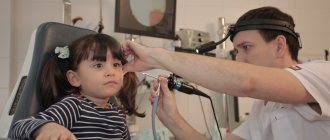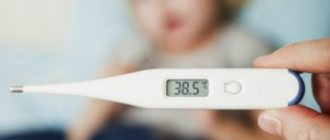After the baby is born, blood tests are taken to assess his health on the first day of life. And this procedure will be repeated systematically, according to a schedule of 1-3-6-9 months and in unscheduled cases. Blood tends to change its composition in various diseases; it is very informative, so you should not be afraid or neglect the doctor’s instructions about taking tests. Blood is collected for different purposes in different parts of the body. In this article we will talk about how blood is taken from a vein from a baby.
In what cases is it necessary to draw blood from a vein to an infant?
Venous blood is taken even from newborns and premature babies. This is often required to determine the level of bilirubin in newborns with jaundice and hemolytic disease of the newborn.
Blood is also taken from a vein to determine its group and rhesus if the baby is undergoing surgery or requires a transfusion of blood or its components (erythrocyte mass, platelets, plasma).
It is necessary to determine the blood type of all newborn children if their mother has the first blood group and negative Rh, since there is a high risk of developing a conflict between the organisms of the mother and child based on blood type and Rh factor.
Very often, blood is taken from a vein from infants if they are being examined for allergies. In these cases, parents are also offered to donate blood for groups of food or household allergens. We can discuss for a long time the advisability of screening children under one year old for allergens, but the topic of today’s publication is different. So we will limit ourselves to stating a fact - to examine a child for allergies, you need to take blood from a vein.
A biochemical analysis of venous blood can be prescribed by a doctor in various situations, as it reflects the functioning of many internal organs. For example, such a study cannot be replaced by anything if it is necessary to evaluate liver function in cases of suspected hepatitis, if there is prolonged jaundice, or an increase in liver size (hepatomegaly). In case of anemia (decrease in hemoglobin level), the specialist is interested in the level of iron, transferrin, and total iron-binding capacity of the serum in blood biochemistry.
The biochemistry of venous blood will also help to assess kidney function if pyelonephritis is suspected and monitor blood glucose levels. Although it must be said that to determine sugar it is not necessary to take blood from a vein. Blood sugar is most often monitored in capillary blood (finger prick).
Useful: How to protect your child from mosquitoes in summer?
To verify various viral and bacterial infections, infants may be prescribed a serological blood test. This may include tests for cytomegalovirus, herpes, chlamydia, whooping cough and other infections. Serological testing also requires blood from a vein.
Blood sampling from a vein is also carried out to determine hormone levels if hormonal pathology is suspected and if it is necessary to exclude genetic diseases.
In general, there are many cases when a baby simply needs to undergo a very unpleasant and painful procedure in order to take blood from a vein.
What influences the analysis result
Why do they take blood from the heel of newborns in the maternity hospital: is it dangerous?
To ensure the reliability of the results, you must try to fulfill certain conditions:
- give the child water to prevent dehydration;
- do not give reason for hysterics and worries, since an increase in the level of certain hormones will affect the readings, which will significantly distort the picture, especially if the analysis was prescribed to identify dysfunctions of the thyroid gland and adrenal glands;
- Do not feed your child 6 hours before taking tests, so as not to distort indicators such as bilirubin, sugar, cholesterol.
A child who can walk and run must get to the test site at a calm pace or in a stroller so that the body does not sweat, the body does not lose fluid, and the blood does not become thick.
baby drinking
Features of the blood vessels of the infant
In children, the location of the superficial veins of the body changes with age. Infants have a dense subcutaneous venous network, and larger veins against its background are not contoured, that is, they are not visible. Only in the second year of life can the saphenous veins of the extremities be clearly identified in this dense network of vessels. But in newborns, superficial veins on the head, in particular on the forehead, are clearly visible.
Infants have well-developed loose subcutaneous fat. This circumstance also makes it somewhat difficult to find a vein.
The structure of the walls of blood vessels at different age periods in infants also has features characteristic of each age. At the same time, there are some structural features of blood vessels and blood flow that are characteristic of all children under one year old.
In babies in the first months of life, the division of the vein wall into membranes is not pronounced (there are three such vessel membranes in adults). The elastic elements are not fully formed even in large veins, so the vessels are less elastic and more fragile.
The number of muscle cells in the structure of the vein wall increases with the age of the child, in fact, when the blood pressure on the vessel wall increases. In children, due to low blood pressure, blood flows more slowly, so it may take longer to draw blood.
Features of analyzes among children
When conducting an analysis, parents must take into account a number of nuances: 1. The results obtained differ from those of an adult patient, since the circulatory system functions differently in a young body. 2. Before the analysis, you need to put your child to bed early. 3. To avoid queues, it is better to go to a private clinic, where they will perform a quick, high-quality and painless blood draw for a fee. 4. To reduce pain, parents can apply anesthetic cream to the baby, but it is important to consult a doctor first.
5. The first analysis is performed when the baby is 5 days old. At the same time, without the consent and notification of parents, doctors do not have the right to perform any type of analysis. 6. A slight deviation in indicators does not indicate the presence of pathology. In this case, the doctor assesses the general condition of the child and, if necessary, prescribes additional examination.
For more information about blood tests among children, see the following material:
What places are there to collect blood from a baby?
Blood sampling in young children is often carried out from a vein in the elbow. If it is not possible to find the ulnar vein, use the veins on the dorsum of the hand, the veins of the forearm, and the foot.
The superficial veins of the head and forehead are a reserve site for blood collection or intravenous infusion and are used in case of emergency.
Parents often ask whether it is possible to replace blood from a vein for analysis with blood from a finger or from the baby’s heel (as many were taken at the maternity hospital). Unfortunately, it's not possible. Capillary and venous blood differ in composition, so one cannot be replaced by the other.
The tests described above also require a relatively large volume of blood (from one and a half to five ml). It is simply impossible to take such a volume from your finger.
In addition, it is not at all a fact that taking blood from a finger is easier and less traumatic than from a vein. Even many adults tolerate blood sampling from a vein better than from a finger. This is often faster and less painful, especially if you have to literally squeeze the blood out of your finger, drop by drop. After this, the finger often hurts for half a day. This happens with adults. And the children have the same picture.
Useful: At what age can a child sleep on a pillow?
What is a lancet?
A lancet is an object with a plastic body, thanks to which a health worker makes a painless puncture of the ring finger, because the design hides the needle. The lancet also has other positive properties: • Low cost - about 20–30 rubles. • Automatic – the puncture force does not depend on the pressure on the finger. • Sterility - the item is packaged in a sealed package, which is opened before analysis. • Speed – puncture is carried out in 2–3 seconds. • Reliability of the results obtained. • Disposable device - after a puncture, the needle is retracted into the body and locked. • Availability - you can buy it at any pharmacy. • Painless – the needle is hidden under a plastic cap. • Individual selection of lancet depending on age and skin type. But how does a lancet work? The health care worker unscrews and removes the protective cap from the device, then places the body on the child’s finger and presses on the child’s finger. After this, the specialist needs to collect the required amount of blood, and in the meantime the lancet is disposed of.
What will help you get blood taken quickly and the first time?
Fortunately, modern equipment has now appeared that can highlight and visually show the course of human veins. Thanks to such visualization, you can easily access any vein, with any location, both for blood sampling and for placing a catheter.
The principle of operation of such devices ( VEIN FINDER VIVO 500, VEIN FINDER VIVO 500S, LUCH-M) is to project a picture of the course of the veins onto the skin, as if the veins were illuminated from the inside in order to see them from the outside. In pediatric practice, this is especially important, since it is in children that loose subcutaneous fatty tissue is very developed, in which the vein is very difficult to find. This situation is popularly called “hiding veins.”
A complicating factor when taking blood from young children is that their blood is thicker and their blood pressure is low. Due to high viscosity and low pressure, blood may not flow well during collection. And if, moreover, the child has to come for the test on an empty stomach, this situation often ends in the fact that they got into a vein, but they could not take a sufficient amount of blood. That is why it is necessary to give the child water before the analysis.
The natural question is: are the innovations in medical technology described above available in all medical institutions? No, they are not available in ordinary hospitals and clinics. And when these devices will be available to a wide range of clinics remains open.
Rules for taking the analysis
Before taking a general blood test, psycho-emotional and physical stress should be excluded.
It is important to avoid dehydration and overhydration, as they can respectively increase or decrease the concentration of cells in the blood. Therefore, it is worth observing the usual drinking and temperature regime. It is optimal to take a general blood test in the morning, on an empty stomach (after fasting for at least 8 hours). When thirst appears, you can drink water. It should be non-carbonated, unsweetened. If an urgent blood test is necessary, biomaterial can be taken during the day, no earlier than 4 hours after eating a small amount of food.
Our advantages
Gentle, minimally painful blood testing for the child by experienced medical personnel
High accuracy - working on a commercial basis, we can afford high-quality reagents, equipment and consumables
Caring for the psychological comfort of our little patients. To remove the possible negativity from taking a blood test, we present children with souvenir medals for bravery
Fast results - we have our own clinical laboratory, so we do not send biomaterial to other medical institutions
Convenience and comfort. Our clinic has a cafe with homemade food, where you can refresh yourself after taking tests. This is especially true when blood must be taken on an empty stomach for testing.
Ability to perform advanced blood tests and many other laboratory or instrumental studies, if necessary
What is the technique for collecting blood from a vein?
The technique of taking blood from a vein for an infant does not differ from that for adults. The same tourniquet is used to clamp the baby’s hand above the puncture site. Treat the site where the needle is inserted into the blood vessel with an antiseptic.
Insert the syringe needle into the vein and take the required volume of blood with the syringe. After this, the tourniquet is relaxed, removed and the needle is removed from the vessel. Apply a cotton swab moistened with an antiseptic and press the injection site to stop the bleeding. If this is not done, blood will continue to leak through the puncture in the vein wall. The result is a bruise (bruise).
Capillary blood sampling
More often, such an analysis is performed after an initial visit to the pediatrician to study several basic blood parameters. The procedure will require the following equipment: alcohol; iodine; cotton wool; smear glass; lancet; ether; disposable gloves; test tube The procedure looks like this: • The patient hands the ring finger of his left hand to the specialist. • The nurse treats the future puncture site with alcohol and makes a puncture on the fingertip. In this case, the first drop is removed. • The specialist draws a blood sample into a test tube, and some of the blood is applied to the glass surface. • Then cotton wool with alcohol is applied to the finger, and the patient leaves the treatment room. Meanwhile, the laboratory assistant marks the tube and sends it to the laboratory for further testing.
What needles and syringes are used for infants?
What volume (size) of a syringe to use to draw blood from an infant depends on the required volume of blood for a particular analysis.
Today, syringe tubes and syringe systems with the possibility of vacuum blood sampling exist and are widely available. Vacuum tubes are labeled differently for each test. They are visually distinguished by multi-colored caps - for a certain type of study there is a different cap color. Each test tube already contains the reagent (preservative) required for analysis.
Useful: How to independently eliminate stretch marks on the skin of the chest and abdomen after childbirth?
The principle of operation of vacuum devices for collecting blood is simple: the test tube has a vacuum vacuum, thanks to which the volume of blood strictly necessary for this particular analysis will be taken. Thanks to this technology, the tube is filled quickly, in about 6-8 seconds.
Another advantage of this system is that the test tubes are made of plastic rather than glass. This circumstance makes them more practical, since the plastic does not break and is easily disposed of.
The special double-sided needle of the vacuum system ensures its tightness. The blood entering the test tube has no contact with the external environment. This increases the accuracy of the analysis.
Even the fact that the part of the needle intended for vein puncture is treated with silicone indicates that this system is well thought out. This treatment makes the process of needle insertion smooth and virtually painless.
Another plus is that the other side of the needle is protected from backflow of blood by a rubber valve. In this regard, the risk of contact of the health worker’s skin with the patient’s blood is further minimized. Thus, vacuum syringe systems are a good replacement for conventional disposable syringes and impractical glass tubes.
Preparation for the procedure
Parents must prepare their child for blood sampling in accordance with the following rules: • Parents must honestly tell the child about the upcoming procedure, but this technique only works among children over 4–5 years old. • In the treatment room, the mother or father must behave calmly, because the child copies the behavior of the parents. • It is important to take the test in the morning on an empty stomach. The last meal will be 9 hours before blood sampling. You are allowed to drink plain water. In addition, it is better for parents to take a sandwich with them, which the child will eat after the unpleasant procedure. • Before the actual tests, the child needs to sit quietly.
• A week before the process, it is important to stop taking medications or parents should notify the doctor about the medications they are taking. • If you have a cold or flu, you need to reschedule tests until after you have recovered. • The day before the procedure, the child should not be physically overexerted. • When repeating blood sampling, it is better to conduct the analysis in the same laboratory at the same time. • In infants, testing should be done between feedings. • While waiting, it is worth entertaining the child with toys. But at the same time, games should be calm. • The child's hands should be warm, but the fingertips should not be rubbed. • During the analysis, it is better to hold the child in your arms so that the baby feels safe. • After the process, praise the baby for his courage and reward him with goodies or a surprise.
What are butterfly needles?
For babies there is such a variety of needles as the butterfly needle. They received their name due to their external resemblance to this insect, since the needle has an elongated catheter and is equipped with two soft stops - “wings”.
This model of needles is designed specifically to ensure that the baby’s movements do not in any way harm the blood sampling or injection procedure. Children are nervous, afraid and cannot sit still during the procedure.
These butterfly needles are so thin that when the child moves, they do not move inside the vein and are not capable of damaging the vessel wall. Thanks to this, “butterflies” have found wide application in resuscitation practice.
I would like to separately note that the emotional state of parents during the blood drawing procedure is incredibly important for the baby. Parents are often very worried, and their anxiety and fear are passed on to the child. This definitely won't make anyone feel any better. Even when it’s all over, the children are already smiling and even laughing loudly, parents often still cannot “move away.”
When going for a procedure if such an examination is necessary, remember and constantly remind yourself that the child will be worse off if he is left without examination. We often have to experience some unpleasant moments in order to feel better later. Taking blood from a vein from a baby is precisely such “evil for good.”
Analysis at home
More than 90% of private clinics offer their clients an additional service - a home visit for blood sampling. This innovation is suitable for parents and children who: 1. Will not be nervous in their own environment. 2. They don’t want to get sick when going outside in the cold season. 3. They don’t want to wait in line. 4. They are not going to catch a virus or infection in the hospital. 5. They cannot adjust their diet to the time of analysis. 6. They want to save time.
Despite a number of advantages, parents should carefully prepare for the upcoming procedure in accordance with the above rules. And another drawback is the high cost of such a trip. During the procedure, the health worker must follow all the rules of the procedure. So, the specialist must prepare a set of disposable instruments and sterile glassware. The results can be found by phone, mail or through the clinic’s website.
Important! The average time for preparing results is from 5 hours to 3 days.
The types of analyzes in greatest demand are: general; biochemical; infectious. As a result, a blood test is a mandatory procedure among children of different ages. At the same time, parents should remember about the preparation and features of the procedure before the analysis, which is discussed in more detail in our material.
When will the results be ready?
If there are no epidemics registered in the city, due to which additional burdens are placed on laboratories, the result will be ready the next day, since health workers take blood from infants early in the morning.
The specialist, having studied the indicators, will decide on making a diagnosis and prescribing treatment. If necessary, the doctor can indicate the period after which you will have to donate blood again.
Each parent can look at the results table to compare the values of their child’s blood parameters with what a given value should normally be.
Important to remember! Making a diagnosis is the doctor’s task; parents just need to follow his recommendations.
The need for analysis
Blood donation is prescribed in a number of clinical cases. For example, material from a vein is necessary to detect an allergic reaction. It is prescribed in case of profuse rashes and peeling on the cheeks. It is advisable to conduct the study in case of a tendency to dermatitis or asthma. A referral for blood donation is issued by an allergist. As a rule, changes can be observed if a large number of irritating particles enter the body. Today there are more than 100 of them. A medical laboratory will conduct a study to identify sensitivity to a certain group of allergens. To analyze the baby, you will need to prepare it in a special way.
A biochemical blood test is necessary if a serious illness is suspected in the baby. It will show any disorder that is observed in the body of infants. Based on such an analysis, hepatitis, liver problems, diabetes mellitus or other life-threatening infectious diseases can be diagnosed.
To diagnose measles, herpes, rubella or toxoplasmosis, blood is taken from newborns for serological testing. Thanks to the results, it is possible to choose the right course of therapy and subsequently test its effectiveness.
The amount of sugar in the blood can only be determined if it was taken from a vein. The disease is diagnosed if there are abnormalities in the functioning of the pancreas. Diabetes also occurs due to disruption of the endocrine system or epilepsy. Biological material from a vein allows you to create a complete clinical picture of the amount of glucose in the blood.
Every person should know their blood type. Such information is necessary in the event of a transfusion or surgery. Data is obtained through such research.











